![]()
Data showing a tripling of hepatitis C cases across America during the last decade highlight urgent and multi-faceted public health needs for expanded access to prevention, screening and treatment in addition to integrated health services that provide care for substance use disorders and associated infectious diseases.
Showing that more than four million adults have evidence of past or current hepatitis C infection, and that nearly two and a half million people in the U.S. are living with the virus now, the data, released today by the U.S. Centers for Disease Control and Prevention, also indicate that half of those infected do not know it.
And, although direct-acting antiviral medicines can now cure most people living with hepatitis C, the majority of those infected have not accessed the treatment. The data show that the consequences of ongoing, undiagnosed and untreated hepatitis C have multi-generational impacts, with most new infections occurring among young adults in 2016, and increasing numbers of infants born to women with the virus, exposed to as much as a seven percent chance of also becoming infected.
The data demand substantial investments in CDC programs carrying out surveillance and providing screening and diagnosis and linkage to treatment. Improved access to, and Medicaid coverage of direct-acting antivirals, for all patients who need them, is essential. In addition, the data highlight impacts of the opioid crisis that will require a large scale up of integrated prevention, treatment and care efforts. The need for innovative models of care for addiction and related infectious diseases, including hepatitis C, is critical, as is investment in the expert workforce to care for these patients. The Infectious Diseases Society of America and the HIV Medicine Association have advocated for robust public health funding to boost surveillance, prevention measures that include syringe exchange services, provider training and care coordination and will continue to call for strong Congressional support and evidence-based action to reduce HCV transmission and expand access to curative HCV treatment.
The tools to eliminate hepatitis C exist, but this goal can only be reached with the support and resources that will be needed to identify all infected individuals, connect them with treatment and prevent new infections.

